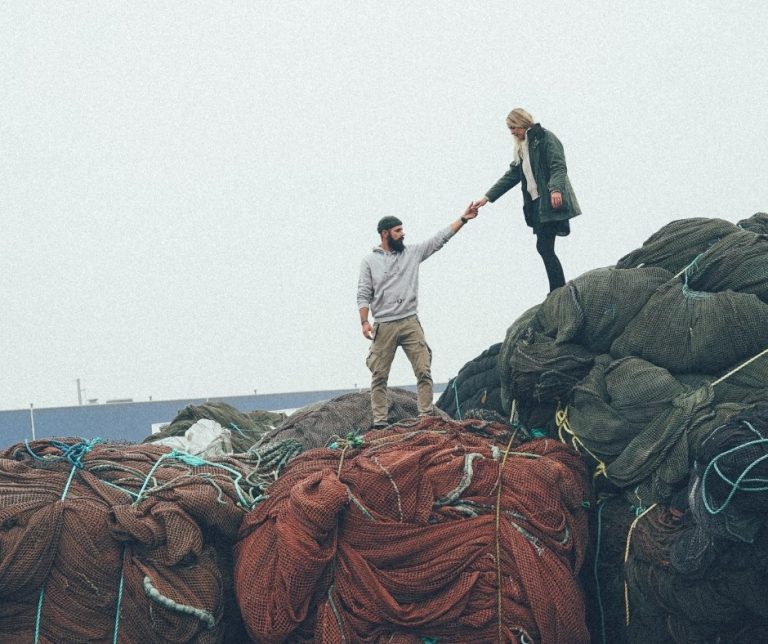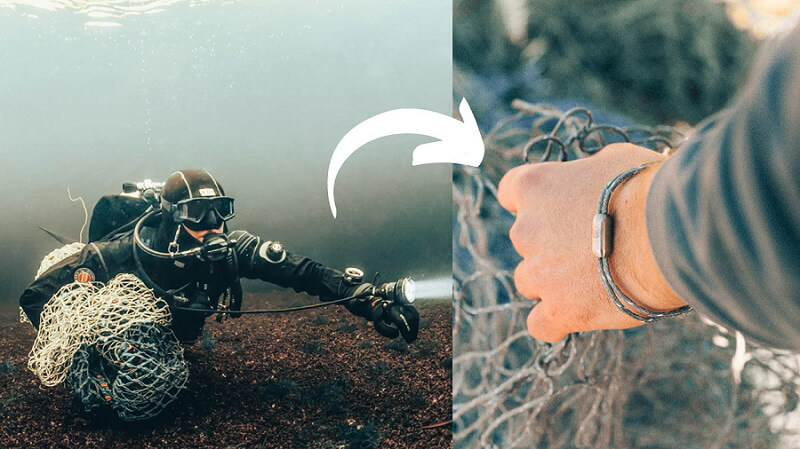We transform old fishing nets into new products, such as our Bracenets. More specifically, we upcycle the nets by hand – meaning, we use them in their original form, without melting them down or combining them with new materials. Instead, we simply cut the nets into individual strands, seal the cut edges, and attach the ends to our clasps (depending on the product model). Therefore, your bracelet is made from a genuine piece of fishing net, complete with its original knots and colors.
But how do we get all these fishing nets? What’s exactly do we mean by terms like “recovered ghost nets”, “discarded fishing nets”, or “former fishing nets”? Does a “North Sea Bracenet” really come from the North Sea? Keep reading to find out!
Where do we get the fishing nets for our products from?
We primarily distinguish between two categories of nets. Firstly, there are ghost nets that our partner organizations retrieve from the seas. We refer to these as “recovered ghost nets.” Secondly, we receive retired, old nets from fisheries, which we term “discarded fishing nets.”
Both types are crucial to our mission of clearing the seas of ghost nets. The first category helps reduce the amount of existing ghost nets, while the second ensures that the nets in question don’t become ghost nets in the first place. Learn more about the danger of ghost nets here.
Recovered Ghost Nets.
Ghost nets pose a global problem, with up to 1 million additional tons of these nets polluting our oceans each year. Drifting across the globe due to ocean currents and tides, they end up in enormous garbage patches, get entangled on wrecks and reefs, and wash ashore on beaches. This demands a global solution – which is why our primary partner organizations, Healthy Seas and Ghost Diving, with their dedicated and specially trained volunteer dive teams, are active worldwide. These are the two organizations to which we have donated the most so far.
Their individual teams regularly set out to sea with their own or rented boats to directly retrieve ghost nets from the water. Through previous dives or reported sightings, they know where nets have become entangled on the seafloor in their vicinity. Their perilous mission then begins: they dive fully equipped to depths of up to 50 meters, freeing the nets in often poor visibility and lifting them to the surface using so-called “lifting bags.” From there, they bring the nets onto the boat and ultimately ashore.
Next, the nets are sorted by material and freed from buoys and metal parts. Nets suitable for our upcycling process due to their condition, material, and thickness are then forwarded to BRACENET. Remaining nets are then recycled.
In addition to Healthy Seas and Ghost Diving, we collaborate with many other organizations, from whom we receive ghost nets from their recovery missions. We turn these nets into special editions to raise funds for their crucial work. For example, Sea Shepherd Germany retrieves ghost nets from the Baltic Sea, the Ocean Voyages Institute retrieves ghost nets directly from the Great Pacific Garbage Patch, and the Papahanaumokuakea Marine Debris Project collects ghost nets from the otherwise largely untouched northwestern Hawaiian islands.
Discarded Fishing Nets
To liberate the seas of ghost nets in the long term, their recovery is crucial – but not enough. Simultaneously, we must work on prevention. That’s why we also collaborate with fisheries, taking in their retired fishing nets or collecting them at ports to ensure they never become ghost nets drifting through the water uncontrolled. Through our upcycling process, we also prevent these nets from ending up in landfills or being incinerated.
But why would retired fishing nets end up as waste in the sea or landfills in the first place? The recycling of fishing nets is often challenging and expensive due to their size and various regulations, making improper disposal much cheaper. We fill an important gap in this system: by not just taking the nets off the hands of fisheries but also remunerating them in some cases, we provide an incentive for fisheries to store their retired nets and recycle them through us at no additional cost.
Another exciting approach: Enaleia, the first school for sustainable fishing in Greece, has set up a collection point for their retired fishing nets in collaboration with Healthy Seas.
Can we trace the origin of our nets?
We always strive to communicate the exact origin of our nets with our products. This is only possible when we directly receive recovered ghost nets or retired fishing nets from an organization or fishery.
For instance, in our collaboration with Sea Shepherd Germany during their Baltic Sea campaign in 2023, we precisely identified the nets: “Ghost net 2023 recovered by Sea Shepherd Germany near Travemünde from the Baltic Sea.” Another example involves an Irish fishery that had been accepting and storing old fishing nets from its surrounding area for many years until they found a way, through us, to give these nets a new life without incurring high disposal costs. In the resulting Bantry Bay Bracenet, we state: “[It is manufactured] from discarded fishing nets that we have received from a fishery in Bantry Bay, Ireland.”
In our collaboration with Healthy Seas and Ghost Diving, however, we cannot always provide such specific details. This is because together with additional partner organizations, they also accept retired equipment from fisheries. As the nets are processed collectively in the subsequent stages, we are unable to make nuanced statements about the origins of the nets. Therefore, in these cases, we typically refer to them as “former fishing nets” to encompass both recovered ghost nets and discarded fishing nets.
Are our product names tied to specific net recovery locations?
We choose the names of our Bracenets to correspond with the marine region they remind us of. This may relate to their color or the origin of the nets, but it doesn’t necessarily mean the nets are sourced from that region. Therefore, a name like “North Sea Bracenet” doesn’t automatically indicate that the net for this bracelet comes from the North Sea.
For instance, we might name a net after the marine region from which our partner organizations first retrieved it. Even if we receive a net of the same color from a different marine region in the future, it will still retain its original name. If you’re interested in the precise origin of the net in one of our products, take a look at the product description. There, we provide as much detail as possible, specifying whether it’s a “recovered ghost net”,”discarded fishing net”, or “former fishing net.”
Can I also send you fishing nets?
Have you come across a ghost net while diving or while walking along the beach? Do you work for a fishery and are unsure what to do with your retired nets? Get in touch with us! Every old fishing net that we render harmless is a gain for the oceans – and it’s even better if we can give it a new life as a statement for the protection of the seas and marine life.
Send us some details about the specific net through this form. We’ll review the information and reach out to discuss how we can proceed. Thank you for your contribution to saving the seas!
Do you have any more questions?
In summary: We acquire former fishing nets for our products from various sources, including both recovered ghost nets and discarded fishing nets. Recovered ghost nets come from our partners like Healthy Seas, Ghost Diving, and Sea Shepherd, who retrieve these nets directly from the seas with their diving teams. Discarded fishing nets come directly from fisheries to prevent them from becoming ghost nets. The exact origin of a specific net can be found in the respective product description.
If you have any further questions, feel free to contact us at [email protected]!









